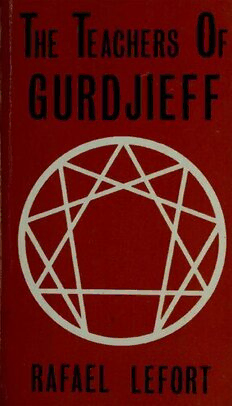
The Teachers of Gurdjieff PDF
Preview The Teachers of Gurdjieff
‘Tae Tencuers Ot GURDJIEFF RAFAEL LEFORT THE TEACHERS OF GURDJIEFF THE TEACHERS OF GURDJIEFF by RAFAEL LEFORT SAMUEL WEISER INC. New York First Published 1966 Fifth Impression 1973 This American Paperback 1975 © RAFAEL LEFORT 1966 SAMUEL WEISER, INC. 734 Broadway New York, N. Y. 10003 ISBN 0-87728-283-8 Printed in U.S.A. by NOBLE OFFSET PRINTERS, INC. New York, N.Y. 10003 > - INTRODUCTION IMMEDIATELY BEFORE THE beginning of the First World War a man of Armenian Greek ancestry, with a background of travel, mysticism and esoterism, arrived back in Russia bringing a mystic teaching. The man was George Ivanovitch Gurdyjieff. His teach- ing was designed to permit, encourage or force man to develop even in spite of himself. Passing from the ‘Institute for the Harmonious Development of Man’ in Tiflis, centres of study in Con- stantinople, Berlin and London and occasional theatrical performances of mystic dancing, he established himself, In 1922, in the Chateau du Prieuré, at Avon near Fon- tainebleau. In this chateau lived, and in the case of Katherine Mansfield died, the pupils and disciples of this man vari- ously described as the ‘twentieth century Cagliostro’ and ‘Master’. His methods attracted wide attention and pub- licity, but no matter what attacks were made upon him the ‘forest philosophers’, as they were called, continued to attract more and more adherents. There was no set ‘ritual’ or ‘course’. Pupils were expected to follow instructions to the letter, read deeply of Gurdjieff’s own writings and learn the complex dance 6 THE TEACHERS OF GURDJIEFF and posture ‘exercises’. Gurdjieff numbered among his adherents Dr. Maurice Nicoll, who had studied under Jung, P. D. Ouspensky, Kenneth ‘Walker, Orage, editor of the influential New Age, Frank Lloyd Wright and a whole host of others who lived to bless, curse or forget him. As the teaching progressed it became more and more clear that much of Gurdjieff’s philosophy was based on eastern ritual, and he himself made frequent reference to dervish practice and the names of characters familiar to students of Sufi thought. One of the most sacred pieces of music to which the ‘movements’ were performed was named after the Syeds or descendants of Muhammed. In 1924 Ouspensky, who had set up groups to study what he had learned from Gurdjieff, broke with him. This break has been the cause of puzzlement and many bad guesses. However, from the sources described in this book it has been possible to obtain the true reasons for it. Gurdjieff wanted to teach Ouspensky to ‘pick up’ the teaching by establishing a bond between them by virtue of which the teacher could transmit to the pupil; but Ouspensky, always the correct and classic intellectual, wanted to be given the ‘principles’ from which to work out the most ‘efficient’ method. Since the system and the method of its transmission are one and the same this intellectual process had no chance of success. Ouspensky revolted against the ‘enigmatic’ character of Gurdyieff’s teaching. He failed to understand that Gurd- jieff could only transmit his message to those who could ‘decode’ the enigmas. This is standard teaching practice, but Ouspensky wanted to arrive at the basis of the teach- INTRODUCTION 7 ing by ‘reasoning it out’ and not by the traditional and most tried, most efficient, method. Up to Gurdyieff’s death in 19409, the teaching saw all manner of ups and downs; it spread to north and south America, but all the time seemed to lack something. After his death it marked time and became less positive with the mainspring gone. Was it the contact with the Source that it lacked? Be that as it may, from the 1950’s onwards it carried on only because of the momentum Gurd)ieft had given it. Movements, readings and lectures continued, and from time to time expeditions sought for contact with the Masters. They sought the Takamour and the Hudakar Monasteries, Yangi Hissar in Kashmir eluded them, and so did Kizil Jan in Turkestan. Perhaps if they had had the knowledge to understand that the transmission of the message is not a right but a privilege granted to those who merit it, need it and stand in the correct relation to the time element, they would have saved themselves much heart-burning. Perhaps, too, if they had had the know- ledge to decode some of the names that Gurdjieff had given them they would have come up with Ashuk ul Haag, Hakim Beg, Bedar Karabeg, Bahauddin Evlia, Ahl Saz and others. Years turned to decades, and the pupils of Gurd)jieff and his successors found themselves no nearer their goal. Recognition had been withheld from those who claimed to have inherited Gurdyjieff’s mandate to teach. His pupils were restless, afraid of trusting their fate to those in whom they could repose little confidence. ‘How can one,’ they reasoned, ‘trust in those who declare ““When I am answer- ing questions, I feel I should be the one asking the ques- 8 THE TEACHERS OF GURDJIEFF tions” and “To make one perfect man takes one hundred thousand years”’ ?’ | This, then, is the background against which my search began. It has ended so far as finding the Source of the teaching is concerned, yet the search to find myself has just begun, but begun with confidence, direction and discipline. R.L.
